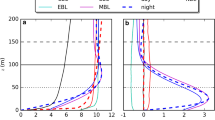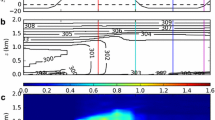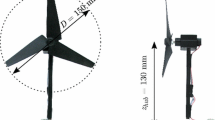Abstract
The wake characteristics of a wind turbine in a turbulent boundary layer under neutral stratification are investigated systematically by means of large-eddy simulations. A methodology to maintain the turbulence of the background flow for simulations with open horizontal boundaries, without the necessity of the permanent import of turbulence data from a precursor simulation, was implemented in the geophysical flow solver EULAG. These requirements are fulfilled by applying the spectral energy distribution of a neutral boundary layer in the wind-turbine simulations. A detailed analysis of the wake response towards different turbulence levels of the background flow results in a more rapid recovery of the wake for a higher level of turbulence. A modified version of the Rankine–Froude actuator disc model and the blade element momentum method are tested as wind-turbine parametrizations resulting in a strong dependence of the near-wake wind field on the parametrization, whereas the far-wake flow is fairly insensitive to it. The wake characteristics are influenced by the two considered airfoils in the blade element momentum method up to a streamwise distance of 14D (D = rotor diameter). In addition, the swirl induced by the rotation has an impact on the velocity field of the wind turbine even in the far wake. Further, a wake response study reveals a considerable effect of different subgrid-scale closure models on the streamwise turbulent intensity.







Similar content being viewed by others
References
Aitken ML, Kosović B, Mirocha JD, Lundquist JK (2014) Large eddy simulation of wind turbine wake dynamics in the stable boundary layer using the weather research and forecasting model. J Renew Sustain Energy 6:1529–1539
Bellon G, Stevens B (2012) Using the sensitivity of large-eddy simulations to evaluate atmospheric boundary layer models. J Atmos Sci 69:1582–1601
Betz A (1926) Windenergie und ihre Ausnutzung durch Windmühlen
Calaf M, Meneveau C, Meyers J (2010) Large eddy simulation study of fully developed wind-turbine array boundary layers. Phys Fluids 22:015110
Chamorro LP, Porté-Agel F (2009) A wind-tunnel investigation of wind-turbine wakes: boundary-layer turbulence effects. Boundary-Layer Meteorol 132:129–149
Doyle JD, Gaberšek S, Jiang Q, Bernardet L, Brown JM, Dörnbrack A, Filaus E, Grubišic V, Kirshbaum DJ, Knoth O et al (2011) An intercomparison of t-rex mountain-wave simulations and implications for mesoscale predictability. Mon Weather Rev 139:2811–2831
El Kasmi A, Masson C (2008) An extended model for turbulent flow through horizontal-axis wind turbines. J Wind Eng Ind Aerodyn 96:103–122
Emeis S (2013) Wind energy meteorology: atmospheric physics for wind power generation. Springer, New York, 198 pp
Emeis S (2014) Current issues in wind energy meteorology. Meteorol Appl 21:803–819
Fröhlich J (2006) Large eddy simulation turbulenter Strömungen. Teubner Verlag/GWV Fachverlage GmbH, Wiesbaden, 414 pp
Froude RE (1889) On the part played in propulsion by difference of fluid pressure. Trans RINA 30:390
Glauert H (1963) Airplane propellers. In: Durand WF (ed) Aerodynamic theory. Dover, New York, pp 169–360
Gomes VMMGC, Palma JMLM, Lopes AS (2014) Improving actuator disk wake model. In: The science of making torque from wind. Conference series, vol 524, p 012170
Grinstein FF, Margolin LG, Rider WJ (2007) Implicit large eddy simulation. Cambridge University Press, Cambridge, 546 pp
Hansen MO (2008) Aerodynamics of wind turbines, vol 2. Earthscan, London, 181 pp
Heimann D, Käsler Y, Gross G (2011) The wake of a wind turbine and its influence on sound propagation. Meteorol Z 20:449–460
Iungo GV, Wu YT, Porté-Agel F (2013) Field measurements of wind turbine wakes with lidars. J Atmos Ocean Technol 30:274–287
Ivanell BS, Mikkelsen R, Henningson D (2008) Validation of methods using EllipSys3D. Technical report, KTH, TRITA-MEK vol 12, pp 183–221
Käsler Y, Rahm S, Simmet R, Kühn M (2010) Wake measurements of a multi-MW wind turbine with coherent long-range pulsed Doppler wind lidar. J Atmos Ocean Technol 27:1529–1532
Kataoka H, Mizuno M (2002) Numerical flow computation around aeroelastic 3D square cylinder using inflow turbulence. Wind Struct 5:379–392
Kühnlein C, Smolarkiewicz PK, Dörnbrack A (2012) Modelling atmospheric flows with adaptive moving meshes. J Comput Phys 231:2741–2763
Mann J (1994) The spatial structure of neutral atmospheric surface-layer turbulence. J Fluid Mech 273:141–168
Manwell J, McGowan J, Roger A (2002) Wind energy explained: theory, design and application. Wiley, New York, 577 pp
Margolin L, Rider W (2002) A rationale for implicit turbulence modelling. Int J Numer Methods Fluids 39:821–841
Margolin L, Smolarkiewicz PK, Wyszogrodzki A (2002) Implicit turbulence modeling for high Reynolds number flows. J Fluids Eng 124:862–867
Margolin L, Rider W, Grinstein F (2006) Modeling turbulent flow with implicit LES. J Turbul 7:1–27
Medici D, Alfredsson PH (2006) Measurements on a wind turbine wake: 3D effects and bluff body vortex shedding. Wind Energy 9:219–236
Meyers J, Meneveau C (2013) Flow visualization using momentum and energy transport tubes and applications to turbulent flow in wind farms. J Fluid Mech 715:335–358
Micallef D, Bussel GV, Sant T (2013) An investigation of radial velocities for a horizontal axis wind turbine in axial and yawed flows. Wind Energy 16:529–544
Mikkelsen R (2003) Actuator disc methods applied to wind turbines. PhD thesis, Technical University of Denmark
Mirocha J, Kirkil G, Bou-Zeid E, Chow FK, Kosović B (2013) Transition and equilibration of neutral atmospheric boundary layer flow in one-way nested large-eddy simulations using the weather research and forecasting model. Mon Weather Rev 141:918–940
Mirocha J, Kosovic B, Aitken M, Lundquist J (2014) Implementation of a generalized actuator disk wind turbine model into the weather research and forecasting model for large-eddy simulation applications. J Renew Sustain Energy 6:013104
Muñoz-Esparza D, Kosović B, Mirocha J, van Beeck J (2014) Bridging the transition from mesoscale to microscale turbulence in numerical weather prediction models. Boundary-Layer Meteorol 153:409–440
Naughton JW, Heinz S, Balas M, Kelly R, Gopalan H, Lindberg W, Gundling C, Rai R, Sitaraman J, Singh M (2011) Turbulence and the isolated wind turbine. 6th AIAA theoretical fluid mechanics conference. Honolulu, Hawaii, pp 1–19
Porté-Agel F, Lu H, Wu YT (2010) A large-eddy simulation framework for wind energy applications. In: The fifth international symposium on computational wind engineering, vol 23–27 (May 2010) Chapel Hill
Prusa JM, Smolarkiewicz PK, Wyszogrodzki AA (2008) EULAG, a computational model for multiscale flows. Comput Fluids 37:1193–1207
Rankine WJM (1865) On the mechanical principles of the action of propellers. Trans RINA 6:13
Schetz JA, Fuhs AE (1996) Handbook of fluid dynamics and fluid machinery. Wiley, New York, 2776 pp
Smolarkiewicz PK, Charbonneau P (2013) EULAG, a computational model for multiscale flows: an MHD extension. J Comput Phys 236:608–623
Smolarkiewicz PK, Dörnbrack A (2008) Conservative integrals of adiabatic Durran’s equations. Int J Numer Methods Fluids 56:1513–1519
Smolarkiewicz PK, Margolin LG (1993) On forward-in-time differencing for fluids: extension to a curvilinear framework. Mon Weather Rev 121:1847–1859
Smolarkiewicz PK, Margolin LG (1998) MPDATA: a finite-difference solver for geophysical flows. J Comput Phys 140:459–480
Smolarkiewicz PK, Prusa JM (2002) Forward-in-time differencing for fluids: simulation of geophysical turbulence. In: Turbulent flow computation. Kluwer Academic Publishers, Boston, pp 279–312
Smolarkiewicz PK, Prusa JM (2005) Towards mesh adaptivity for geophysical turbulence: continuous mapping approach. Int J Numer Methods Fluids 47:789–801
Smolarkiewicz PK, Pudykiewicz JA (1992) A class of semi-Lagrangian approximations for fluids. J Atmos Sci 49:2082–2096
Smolarkiewicz PK, Winter CL (2010) Pores resolving simulation of Darcy flows. J Comput Phys 229:3121–3133
Smolarkiewicz PK, Sharman R, Weil J, Perry SG, Heist D, Bowker G (2007) Building resolving large-eddy simulations and comparison with wind tunnel experiments. J Comput Phys 227:633–653
Tossas LAM, Leonardi S (2013) Wind turbine modeling for computational fluid dynamics: December 2010–2012. Pat Moriarty, NREL Technical Monitor, pp 1–48
Troldborg N, Sørensen JN, Mikkelsen R (2007) Actuator line simulation of wake of wind turbine operating in turbulent inflow. In: The science of making torque from wind. Conference series, vol 75, p 012063
Wedi NP, Smolarkiewicz PK (2004) Extending Gal-Chen and Somerville terrain-following coordinate transformation on time-dependent curvilinear boundaries. J Comput Phys 193:1–20
Wedi NP, Smolarkiewicz PK (2006) Direct numerical simulation of the Plumb-McEwan laboratory analog of the QBO. J Atmos Sci 63:3226–3252
Wildmann N, Hofsäß M, Weimer F, Joos A, Bange J (2014) MASC—a small remotely piloted aircraft (RPA) for wind energy research. Adv Sci Res 11:55–61
Witha B, Steinfeld G, Heinemann D (2014) High-resolution offshore wake simulations with the LES model PALM. Wind energy—impact of turbulence, Spring 2012. Oldenburg, Germany, pp 175–181
Wu YT, Porté-Agel F (2011) Large-eddy simulation of wind-turbine wakes: evaluation of turbine parametrisations. Boundary-Layer Meteorol 138:345–366
Wu YT, Porté-Agel F (2012) Atmospheric turbulence effects on wind-turbine wakes: an LES study. Energies 5:5340–5362
Zhang W, Markfort CD, Porté-Agel F (2012) Near-wake flow structure downwind of a wind turbine in a turbulent boundary layer. Exp Fluids 52:1219–1235
Acknowledgments
The authors thank Mark Zagar for providing the airfoil data of the 10 MW reference wind turbine from DTU and Fernando Porté-Agel for the constructive discussion on our work in a previous state. This research was performed as part of the LIPS project, funded by the Federal Ministry for the Environment, Nature Conservation, Building and Nuclear Safety by a resolution of the German Federal Parliament. The authors gratefully acknowledge the Gauss Centre for Supercomputing e.V. (http://www.gauss-centre.eu) for funding this project by providing computing time on the GCS Supercomputer SuperMUC at Leibniz Supercomputing Centre (LRZ, www.lrz.de).
Author information
Authors and Affiliations
Corresponding author
Rights and permissions
About this article
Cite this article
Englberger, A., Dörnbrack, A. Impact of Neutral Boundary-Layer Turbulence on Wind-Turbine Wakes: A Numerical Modelling Study. Boundary-Layer Meteorol 162, 427–449 (2017). https://doi.org/10.1007/s10546-016-0208-z
Received:
Accepted:
Published:
Issue Date:
DOI: https://doi.org/10.1007/s10546-016-0208-z




